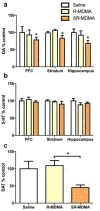Separating the agony from ecstasy: R(-)-3,4-methylenedioxymethamphetamine has prosocial and therapeutic-like effects without signs of neurotoxicity in mice
- PMID: 28993129
- PMCID: PMC5714650
- DOI: 10.1016/j.neuropharm.2017.10.003
Separating the agony from ecstasy: R(-)-3,4-methylenedioxymethamphetamine has prosocial and therapeutic-like effects without signs of neurotoxicity in mice
Abstract
S,R(+/-)-3,4-methylenedioxymethamphetamine (SR-MDMA) is an amphetamine derivative with prosocial and putative therapeutic effects. Ongoing clinical trials are investigating it as a treatment for post-traumatic stress disorder (PTSD) and other conditions. However, its potential for adverse effects such as hyperthermia and neurotoxicity may limit its clinical viability. We investigated the hypothesis that one of the two enantiomers of SR-MDMA, R-MDMA, would retain the prosocial and therapeutic effects but with fewer adverse effects. Using male Swiss Webster and C57BL/6 mice, the prosocial effects of R-MDMA were measured using a social interaction test, and the therapeutic-like effects were assessed using a Pavlovian fear conditioning and extinction paradigm relevant to PTSD. Locomotor activity and body temperature were tracked after administration, and neurotoxicity was evaluated post-mortem. R-MDMA significantly increased murine social interaction and facilitated extinction of conditioned freezing. Yet, unlike racemic MDMA, it did not increase locomotor activity, produce signs of neurotoxicity, or increase body temperature. A key pharmacological difference between R-MDMA and racemic MDMA is that R-MDMA has much lower potency as a dopamine releaser. Pretreatment with a selective dopamine D1 receptor antagonist prevented SR-MDMA-induced hyperthermia, suggesting that differential dopamine signaling may explain some of the observed differences between the treatments. Together, these results indicate that the prosocial and therapeutic effects of SR-MDMA may be separable from the stimulant, thermogenic, and potential neurotoxic effects. To what extent these findings translate to humans will require further investigation, but these data suggest that R-MDMA could be a more viable therapeutic option for the treatment of PTSD and other disorders for which SR-MDMA is currently being investigated.
Keywords: Enantiomers; MDMA; Neurotoxicity; PTSD; Prosocial.
Copyright © 2017 Elsevier Ltd. All rights reserved.
Conflict of interest statement
None of the authors have financial or other conflicts of interest to report
Figures





Similar articles
-
Pharmacological characterization of the effects of 3,4-methylenedioxymethamphetamine ("ecstasy") and its enantiomers on lethality, core temperature, and locomotor activity in singly housed and crowded mice.Psychopharmacology (Berl). 2003 Mar;166(3):202-11. doi: 10.1007/s00213-002-1261-5. Epub 2003 Feb 1. Psychopharmacology (Berl). 2003. PMID: 12563544
-
Serotonin synthesis inhibition reveals distinct mechanisms of action for MDMA and its enantiomers in the mouse.Psychopharmacology (Berl). 2005 Sep;181(3):529-36. doi: 10.1007/s00213-005-0005-8. Epub 2005 Oct 12. Psychopharmacology (Berl). 2005. PMID: 15983787
-
The role of temperature, stress, and other factors in the neurotoxicity of the substituted amphetamines 3,4-methylenedioxymethamphetamine and fenfluramine.Mol Neurobiol. 1995 Aug-Dec;11(1-3):177-92. doi: 10.1007/BF02740694. Mol Neurobiol. 1995. PMID: 8561961
-
The pharmacology and clinical pharmacology of 3,4-methylenedioxymethamphetamine (MDMA, "ecstasy").Pharmacol Rev. 2003 Sep;55(3):463-508. doi: 10.1124/pr.55.3.3. Epub 2003 Jul 17. Pharmacol Rev. 2003. PMID: 12869661 Review.
-
The effects of ecstasy on neurotransmitter systems: a review on the findings of molecular imaging studies.Psychopharmacology (Berl). 2016 Oct;233(19-20):3473-501. doi: 10.1007/s00213-016-4396-5. Epub 2016 Aug 28. Psychopharmacology (Berl). 2016. PMID: 27568200 Free PMC article. Review.
Cited by
-
Is the stereoisomer R-MDMA a safer version of MDMA?Neuropsychopharmacology. 2024 Dec;50(2):360-361. doi: 10.1038/s41386-024-02009-8. Epub 2024 Oct 24. Neuropsychopharmacology. 2024. PMID: 39448866 Free PMC article. No abstract available.
-
5-HT2C receptors in the nucleus accumbens constrain the rewarding effects of MDMA.bioRxiv [Preprint]. 2024 Oct 22:2024.10.20.619256. doi: 10.1101/2024.10.20.619256. bioRxiv. 2024. Update in: Mol Psychiatry. 2025 Jul 24. doi: 10.1038/s41380-025-03128-4. PMID: 39484424 Free PMC article. Updated. Preprint.
-
Swim in the Chiral Pool: MDMA and MDA Enantiomers from Alanine-Derived Precursors.ACS Omega. 2023 Jun 6;8(24):22132-22137. doi: 10.1021/acsomega.3c02358. eCollection 2023 Jun 20. ACS Omega. 2023. PMID: 37360440 Free PMC article.
-
Ecstasy, molly, MDMA: What health practitioners need to know about this common recreational drug.Dis Mon. 2025 Mar;71(3):101851. doi: 10.1016/j.disamonth.2024.101851. Epub 2025 Jan 14. Dis Mon. 2025. PMID: 39814637 Review.
-
Altered brain activity and functional connectivity after MDMA-assisted therapy for post-traumatic stress disorder.Front Psychiatry. 2023 Jan 12;13:947622. doi: 10.3389/fpsyt.2022.947622. eCollection 2022. Front Psychiatry. 2023. PMID: 36713926 Free PMC article.
References
-
- Anderson GM, Braun G, Braun U, Nichols DE, Shulgin AT. Absolute configuration and psychotomimetic activity. NIDA Res Monogr. 1978:8–15. - PubMed
MeSH terms
Substances
Grants and funding
LinkOut - more resources
Full Text Sources
Other Literature Sources
Medical
Research Materials

